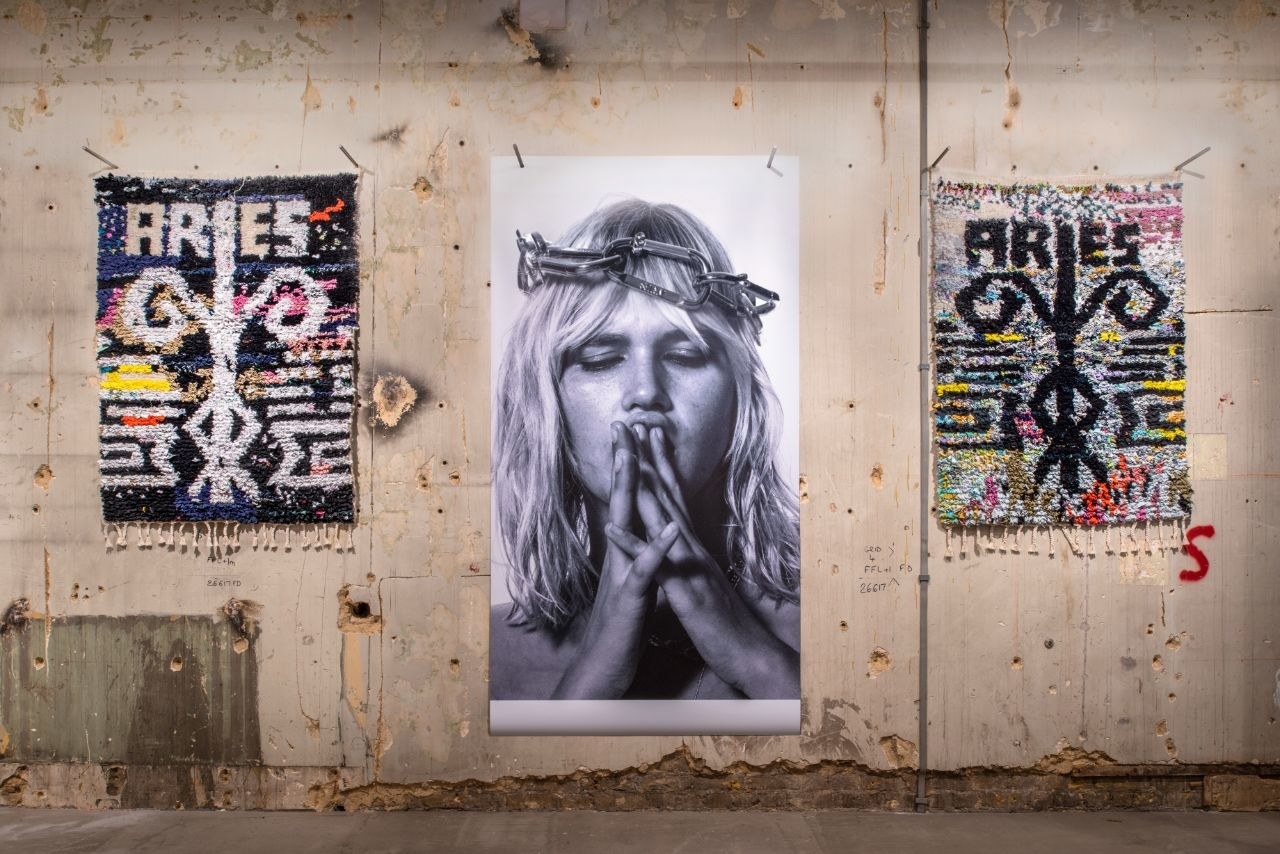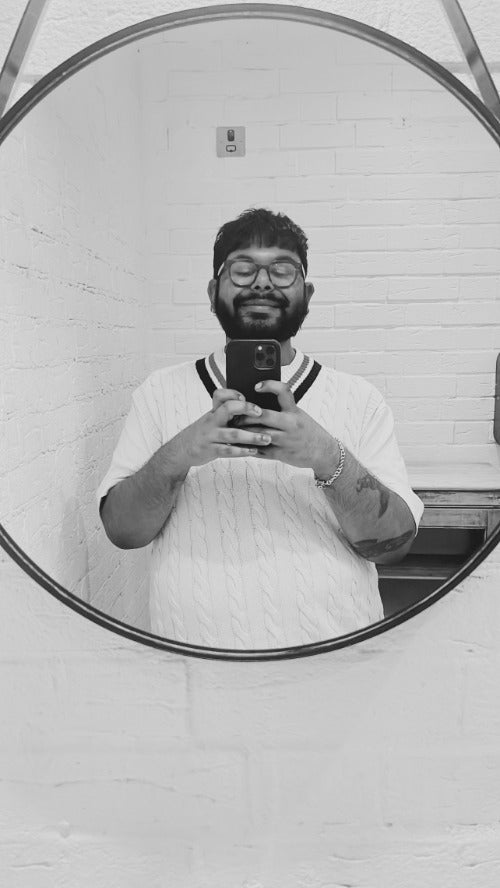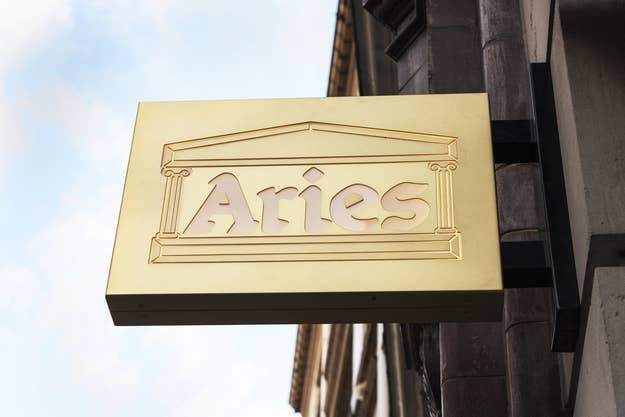
For most fashion labels, launching a brick-and-mortar store is the ultimate goal, their chance to share art with the world and build a community at the centre of it all. And this is exactly what Sofia Prantera wanted to do with her popular streetwear label, Aries, who has broken new ground with its first retail location in London (Soho).
The 4,000 square ft store has been created to deliver an immersive, visually stunning experience with a two-story layout that showcases Aries’ innovative, co-ed fashion ideals and multi-disciplined curated notions. Designed in close collaboration with Brinkworth & Wilson Brothers, you’d be forgiven if you mistook the space for an art gallery if it wasn’t for the presence of Aries’ enigmatic silhouettes.
Referencing traditional British techniques and Italian craftsmanship, the label’s new London home is both rugged and elegant, with a striking juxtaposition of cement flooring, bespoke wooden furniture, and grand scaffold staircase adorned with sleek marble detailing. But that’s not all: visitors to the west end outpost can also expect to encounter a range of slick and exclusive partnerships from a range of ever-evolving entities, including leading vintage resale brand Jerks, and jewellery imprint Bunney.
The space is also home to Paperboy’s first location outside of Europe, as well as sandwiches and coffee in collaboration with East London’s Dark Arts Coffee. We caught up with founder Sofia Prantera to discuss the new store and her journey as a designer. Tap in after the jump.
“As my career has gone on, I feel like I have fallen into a lot of things, as opposed to making my own path. Maybe there is something in that.”

COMPLEX: What initially attracted you to London?
Sofia Prantera: I grew up in Rome but my mother is English, so that definitely helped with my decision to come here. We’re a really strong family and I think my mother realised that from quite young, it was important that she pushed to break the traditional mould. I live here with my sister now, but when we were younger, my mother used to come to London to see various art projects and return with all these things that would pique my interest. Over the years, I realised this was the place to be; there is definitely a feeling of being free here. I love Rome, but I’m so glad I didn’t stay there. Milan is more cosmopolitan, whereas Rome is still quite small, very beautiful, but quite self-contained. I feel like my mum was very much like “go!” and didn’t hold us back. Coming from a half-and-half background, you are somehow a product of two things, and I am now realising how important and defining it is to feel never quite right in two different places, or to fit in. It was a very big decision to move, but very defining in the end.
You studied at Central Saint Martins, a university famed for its prestigious alumni. What was your experience like there?
That’s a good question… It was so long ago! Firstly, it was all about coming into contact with such creativity. In Italy, we don’t really have a creative education. You’re not made to study art. I studied something called ‘classical studies’, where we learned subjects like Greek and Latin. It was very high-brow, for lack of a better word. I didn’t actually study art; I studied the history of art. When I got to Central Saint Martins, I was amazed by what the students were doing. We were doing things that I didn’t think were even possible—it was really inspiring. I graduated in 1991, around the same time as designers like Alexander McQueen, but I was always much more interested in sports. Even there, I felt like I didn’t really fit in. However, at the same time, it was a place where I still absorbed a lot. I have kids now who are going to college, and I think a place like CMS gives you the licence to call yourself something. When I was studying there, I was able to call myself a fashion designer, which then gave me the ticket for things when I got out. As my career has gone on, I feel like I have fallen into a lot of things, as opposed to making my own path. Maybe there’s something in that.
You then went on to work with Russell Waterman at Slam City Skates, and later co-founded Silas with him. How did that all come about?
I started working at Slam City Skates through a friend that I went to college with. She knew one of the skaters there at that time, and was aware that they were looking for someone who could design sportswear. I was really into subcultures and sportswear—my graduation collection was based on Stone Island, as well as casualwear. During my time there, I launched a brand called Holmes, which was a skate brand within Slam City Skates, and later, founded Silas with my co-worker Russell Waterman. We invented this thrifted guy who was in his 50s because I didn’t want to make anything under my own name. I’ve never felt comfortable being myself, so instead we created an entity. It was here that we launched our first business independently. I was quite young, so to look back now, I think it’s great.
Moving on to Aries, did you ever imagine how successful the label would be when you first started out?
Never! I mean, Silas was quite a big brand in itself, but it was done by a business partner in Japan. I stopped in 2008, and when I started Aries, I really had no idea what I was doing. I wanted something that was way more hands-on, compared to Silas where we were just producing and manufacturing, where I could go back to the idea of just making things. I started off by making DIY-style T-shirts and jeans, which were all designed in-house. My business partner, Nicki [Bidder], was very instrumental in the brand’s growth. I always knew I wanted to do it with someone, but when she came along, I think we were very aligned on the idea of being big. Overall, I’m more introverted and I like to do stuff for myself, as opposed to motivating a whole team of people. Aries has had a very organic growth, and I think there are only two ways of doing this: you can either be very ambitious and get investment, or you can do things when you feel it’s the right time.

In the past, you’ve said that you draw a lot of inspiration from British counterculture and subcultures. What’s keeping you creative right now?
I never really thought that I was a creative person. I’ve had to deal with imposter syndrome at times because of my traditional upbringing. Initially, I felt that my creativity was something that I never really nurtured, but then realised there are a million ways of being creative. I’m inspired all the time and never really struggle with ideas; to be honest, there are probably people that struggle to work with me because I always want to change or refine our ideas. It never really feels like a continuous flow. Now that I’ve had children, I’m sort of learning about the different types of creativity. There’s a certain mind that is very ADD, which my child has, and I’m now recognising it in myself. It’s like being surrounded by all of your favourite things in a candy shop, but there’s a way of achieving those goals, especially as you get older. It’s also easier to harness your creativity when you experience this. I think younger people who have that rapid-fire mindset can find things hard, especially when you lack experience. I recently heard someone say that creative people are very unemployable and I think that’s a great example of what is wrong with the creative industry. A lot of these people aren’t nurtured because they’re seen as chaotic or subversive and are sadly weeded out early on.
Do you feel the difference between the fashion scene in the UK and Italy?
When I was growing up in Italy, the fashion scene was modelled on what was happening in the UK. Looking back, I came here to find that. I think a lot of people still do, less so now, because there’s a lot of stuff happening everywhere else. There was also a lot of looking to London’s club culture for inspiration; it was a place where things were happening, which were shaped by magazines like The FACE and i-D. I think the fashion scene in Rome is non-existent, and in Milan, it’s very different. To be honest, I only ever discovered Milan maybe about ten years ago; I never went there when I was a kid.
How would you describe the current state of the streetwear industry?
I’m old enough now to have lived through enough of these cycles. For me, all subcultures, cultures and trends go through cycles, but they’re then exploited by big business. It’s at this point where people like us may get bored of it. When we talk about the burnout of fashion cycles, it’s because you’re looking for something that’s been exploited. Any Tom, Dick or Harry is making joggers, and as a consumer, you don’t want to belong to it because they’ll be splattered everywhere. The reality is that as long as your company is independent, you still have the ability to do things differently. Nowadays, the trend-seekers are looking for the spirit of newness, and I think we’re going beyond a trend. I was in skatewear when it became trendy and exploited, and I think it is still a really interesting scene.

Some would argue that Aries is quite minimal in its look—what inspired that, and would you ever go full-on logo mania in the future?
As a brand, Aries has elements of minimalism and maximalism throughout its DNA. I’m very into keeping things toned down; there’s definitely a “normcore” element in everything that we do. As a business, we’ve followed a less direct-to-consumer approach and more of a wholesale model which has meant that “normcore” doesn’t sell, because of our online presence. What people have picked up on is the brashness, loudness and weariness that Aries exhibits. With the opening of the store, I’m hoping to carry both of these elements. As a whole, I’d say our clothes don’t need to be heavily branded for people to like them, but they do need to be overly branded for people to notice them.
What are your thoughts on the whole Y2k trend right now?
The whole thing has sort of gone for me. When I started Aries in 2009, the skate scene had just blown up thanks to brands like Palace. I employed this girl in 2013, and she was literally Y2K everything. For me, the whole thing was a very difficult time. But really that was ten years ago. I now have a 17-year-old daughter but they are definitely looking to influence elsewhere.
The store is obviously a huge moment for Aries. Was there a reasoning behind opening in London’s Soho area?
We didn’t even question anywhere else—it had to be Soho. There are a lot of like-minded brands here and the community we’re reaching out to also are based in the area. Weirdly, I think maybe ten or fifteen years ago, we could have looked at somewhere in East London, but I don’t think that’s where the brand is now. Even when we first started looking for spaces, I knew Soho was the place to be—it’s the heart of London!
Can you tell me about the inspiration and style that influenced the space?
We always knew we were going to be a big space. It was never going to be a small store on the main road, but always a big store on the side road. We wanted to create a shop where you could hang out and would feel comfortable having events in. It was designed by Adam, who is an old friend and actually designed the Supreme Hollywood store. He loves what we do and had a clearer idea of who we are than I did when we started the initial meetings. We love hosting and we wanted a place of our own where you could change the fixtures if we needed, which is achieved by the size of the space. The design is a combination of our pop-up stores and what Aries is, which is a strange brand that sits in between lots of different things. I always wanted it to look luxe; a lot of the architecture is inspired by Italian artists of the 1950s, ‘60s and ‘70s.
What’s your favourite part of the store?
It has to be the staircase. For me, it’s the real focus of the space and was really the only thing that we didn’t edit out when it came down to cost. It takes inspiration from Carlo Scarpo’s architecture, but also the marble that can be found in San Marco, Venice. It also has this temporary DIY element to it, even though it isn’t. It’s how you distil what Aries is: it’s strange, unexpected and arty, but also quite trashy. Most importantly, it always needs to always have a purpose—if it doesn’t have a reason for existing, then it’s something I can’t get behind. We had a lot of ideas at the start, which we’re hoping to implement down the line, but I don’t think a lot of people realise that we’re not a brand that has had investment from outside. Everything is reflective of that—it’s not just someone coming in and throwing money at us.

Can you break down some of the exclusives that the outpost will house?
The idea is mainly to have books and music in the future; we’re hoping to make that more permanent as we bring new people in. We love clothing but I think that product has had its time and people need more. Even when we started Aries, it was quite serendipitous. The way of communicating through heavily branded clothes has always worked really well, however people are now looking for something more in-depth, and I think putting something more cultural within the clothes is where we align.
What do you hope the opening of the store will mean to Aries fans, both old and new?
When you’re competing against other brands at a higher price point, consumers are going to want maximalist designs, where they can see what they are buying—especially when it’s in a retail space. I think the new store gives us the opportunity to show the quieter side of Aries, especially some of the less obvious stuff of what we do.
What do you hope will be your legacy with Aries?
That’s a really interesting question. I’ve had to really look into myself. As a society, we’re used to associating our successes with wealth, but that’s not something I can really align with. I measure my success with the knowledge that people love Aries, and that’s what I hope my legacy will be.

